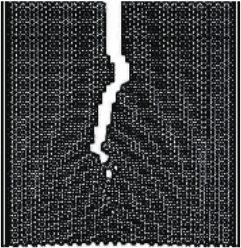Nonequilibrium systems show dynamical phenomena such as transport and relaxation, which is different from equilibrium systems. Although it is well known about the linear response theory valid in the linear regime near equilibrium, there is no general theory covering systems far from equilibrium. In our laboratory, we are trying to search for a fundamental theory of nonequilibrium systems mainly through studying transport properties of lattice models.
Lattice Thermal Conduction
|
Thermal properties of equilibrium solids such as specific heat are well explained using systems of particles connected by linear springs as in Debye theory. In nonequilibrium systems, however, this model fails to explain Fourier heat law that heat current is proportional to the temperature gradient. It is because no phonon scattering occurs in the linear model. Nonlinear terms ignored in equilibrium theory become important in nonequilibrium systems. We have investigated various properties caused by the nonlinear terms and nonequilibrium boundary conditions. One example is the deformation of momentum distribution in heat conduction states. Moreover, we have also discussed heat conduction in quantum systems where spin degrees of freedom carry heat.
|  |
Cellular Automata with Conserved Quantities
|
Cellular automata (CAs) are fully discrete dynamical systems where dynamical variables on a lattice evolve their discrete values in discrete time steps. They are widely used to simulate various physical phenomena because they are well suited for computer treatment. We have investigated basic issues such as existence or nonexistence of conservation laws in CAs and statistical and dynamical properties of such conserved quantities. As the result, we have clarified that heat conduction can be argued in reversible CAs with conserved quantities. Moreover, nonreversible CAs with conserved quantities share transport properties with dissipative particle systems like granular systems and traffic flows.
|
Fracture Toughness in Composite Systems
|
Fracture of solids is an extremely nonequilibrium phenomenon that is not only technologically important but also physically interesting. It is modeled by a network of fuses or springs that are broken when current or force over a threshold value is exerted. We have investigated how fracture toughness changes if the spring constants or the resistances have randomness. Our results show that, although counterintuitive, composite systems can be tougher than uniform systems.
|  |
